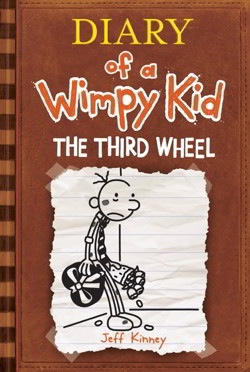I know, I know! We have been arguing for such a long time that comics aren’t just for kids but the problem is that a majority of the comics publishers have neglected to realize that this is and will always be tomorrow’s adult comics fan. With the acceleration of the Children’s and Young Adult categories, the traditional publishers are dominating a market segment that for some reason, still isn’t registering with the folks who made it possible in the first place.The reason why comics are also for kids is because this is where we create reading behaviors. So many of us ‘mature’ readers discovered our passion for the act of reading via the first comics we could buy. These were the very cheap floppies you could find on the news stand, drug store, grocery store or the mom and pop corner market. We didn’t care about who wrote the stories, we didn’t collect them, we devoured them even before we made it to the register and then we read them over and over until we could buy some more.
I mentioned in Chapter 2 that All Ages is not a category listing in the traditional book market and that is quite true. In fact, All Ages is a financially damaging designation that comics publishers need to abandon as do the editorial staff and creators. Because it doesn’t exist in the book trade, which is worth billions of dollars more than the direct market, All Ages prevents a book from any chance of realizing true success.
Editorially, it is equally damaging because there are too many folks who think their story is All Ages when it really isn’t. Here’s the thing: writing for kids doesn’t mean dumbing down the dialog and pumping out trite crap. Kids are intelligent readers but they also like fact-based stuff like books about sharks, princesses, wookies, zombies etc. They just don’t care about the angst and over-sexualized characters who are struggling with the inner turmoil that the older comics fans get into.
Ironically, we are dealing with a situation where older fans, readers and publishers of the comics medium are trying to dictate what they think the kids should be reading versus what the kids want to read. Sound familiar? This mentality has been with us since the 1880s when a group of academics and publishing elite decided what classic literature is supposed to be. Dime store novels were an explosive new category in the U.S. market. Why? Because the average Joe could afford to buy a dime store novel. Reading, as a form of entertainment for the average citizen, began to grow.
Even before comics went four color in the Sunday editions of newspapers around the country, a new wave of European immigrants were learning how to assimilate into the culture of a new land. Even then the literary elites were looking down on the comics medium, declaring it unfit for consumption. It was entertainment for a lesser people. If you want real reading then you must read the classics!
There’s a great scene in the movie High Fidelity where John Cusack and his guys in the record shop berate a customer because he just wants to buy a record for his daughter. Even though they have the song they won’t sell it because it is ‘sentimental tacky crap’. So, instead of ringing up a sale, they have decided that the customer should buy what they deem ‘cool’ versus what he asked for. The customer leaves the store, frustrated.
Kids want and are buying stories like Bone, Archie, Smile: A Dental Drama, Amelia Rules! Ook and Gluk, and yes, they are buying Diary of a Wimpy Kid. The thing is, they aren’t buying these books at the comics shops; they are buying them in the normal retail outlets and they are buying them in the school book fairs.
Diary of a Wimpy Kid is NOT A GRAPHIC NOVEL!!!! Well, I’ll say that technically and more importantly to the buyer in the education, library and retail market it now represents the graphic novel category for kids. The buyers are seeing crazy demand for it and according to some recent articles in the trades, the Wimpy Kid has generate [generated] more than $700 million for Abrams (Charlie Kochman is a freakin’ genius for landing it, too) and with those kinds of stories hitting the press you can bet the rest of the major houses are trying to find the next graphic novel series for kids.
I’ll leave you with two examples of brilliant marketing schemes that ensure a future for those companies. Disney and McDonald’s are both companies who have specific marketing campaigns that follow you from cradle to grave. McDonald’s has Happy Meals because little kids really don’t care about ranch style Angus burgers-they just want the toy and they may or may not eat the food. They do go back as teenagers and they do return as parents with little ones who will eat the Happy Meal while they eat the Angus Deluxe with Ranch Dressing.
Disney hooks you with the movies, toys and dreams of going to Disneyland or Walt Disney World. As a parent, you can bet you’ll be bombarded with special editions of The Lion King or The Little Mermaid every quarter of the business calendar. Eventually, your kids will lobby you long enough that you will cave and take them to one of the theme parks near you.
Don’t be afraid to write and sell to kids…just don’t call it All Ages because the district buyer in the Las Vegas Clark County Library System won’t be able to find an all ages title in the ordering system.
If you are a publisher or creator who is trying to figure out whether the book is for Children, Young Adults, or Adult readers I’d suggest contacting some great librarians who can help you out with that. It’s worth the time and the effort.
In the next chapter I’ll cover the launch of the campaign efforts and the machine that makes sure you see that book on the best seller lists-or gives it a helluva try.










That said, the Las Vegas-Clark County Library District does a fantastic job stocking comic books.
Really enjoying these articles.
Hey Nora, this is quite true! In fact, Las Vegas CC has an incredible collection across the board for Adults, YA and Children. They along with LA, NYPL, Queens Public, Boston, Seattle…there are some great library systems out there who are way ahead of the curve when it comes to buying comics.
“Even though they have the song they won’t sell it because it is ‘sentimental tacky crap’.”
Yup… ran into this with my co-workers at the bookstore. My dictum:
If it’s crap and it sells, it’s not crap.
(Harlequin has made a consistent fortune on a few genres. Take a look at the outlines for each imprint:
http://www.harlequin.com/articlepage.html?articleId=538&chapter=0
Imagine if they acquired a comics publisher!)
Also, if one takes an optimistic view, that reader will probably return looking for other titles to read. At this point, the bookseller whips out the Outrageous Customer Service and begins to recommend the Good Stuff.
—
Here’s something about Wimpy Kid I noticed… there’s a “do-it-yourself” book which sells as well as the novels. Now, the optimist will look at that and speculate on how many of those kids will become cartoonists. The pessimist will look at that and anticipate a fresh wave of indulgent indie autobiocomics.
“The thing is, they aren’t buying these books at the comics shops;”
Sure they are… you just have no way of seeing it because the stores that are selling these books in reasonable quantities are mostly buying them from Anywhere But Diamond.
-B
John, It’s good to see your work online and I agree with you about the genius–or at least discerning taste–of Charlie Kochman. Your all-caps declaration that Wimpy Kid IS NOT A GRAPHIC NOVEL is at least debatable: I don’t think it’s ever been nominated for an Eisner, but the Harvey folks seem to think it qualifies for regular multiple nominations. Although the books are mostly text with illustration, they do also have drawings in sequence that tell little stories–comics.
I got to discuss the very topic of what Wimpy Kid is with Messr. Kinney and Kochman about five years ago. My take-away: after you sell the first two or three million, the only people who care what they’re called are the clerks who have to shelve them. I call them “books that 50 million kids like to read.”
Interesting insights into “All Ages.” I did not know that and will strategize accordingly. I think books CAN straddle or cross over. I did two graphic novels intended for adult readers (as, in fact, Kinney originally pitched Wimpy Kid) that both got mileage as Young Adult. I didn’t know I’d written kids’ books but will gratefully take readers any way I can get ’em.
Well put Mr. Hibbs! I do know there are more than a few comic shops who have discovered alternate purchasing options via Baker & Taylor, Ingram and a few others. These are also the shops that have figured out the opportunities that kids represent.
Torsten, do you remember when Dark Horse and Harlequin partnered for some manga titles that were printed in red ink? Oy, how crazy was that? I think Harlequin would do quite well with a line of romance graphic novels. I’d hesitate at recommending manga again-unless the stories were written by the likes of CLAMP.
And you’re right, if it sells it aint crap. Steven King has sold many, many millions of books and it’s only recently that the traditional publishing world began to recognize him as a master author.
Hi Brian, it’s great to hear from you as well. Personally, I do see Wimpy Kid as a comic/graphic novel. Jeff Kinney launched the series as a web comic and he’s mastered the art of blending prose with sequential art. I think the simplistic art style has deceived too many folks, kind of in the same way Groening or Schultz may have not been fully appreciated. One of the things I appreciate about Jeff is his willingness to give them(the readers) more of what they want.
As for the observation about what clerks call graphic novels versus what kids are calling them? You are spot on. Kids just call them books and about the only time there is a differentiation is when it comes to manga.
Yes, books can cross over the demographics-take Harry Potter or the Twilight series as examples. BUT, they were initially sold into the children’s or the teen/YA category first because the buyers needed to understand what audience the marketing was going to target. Once the books hit the shelves, get notice and gain traction then the crossover can happen. I’m going to cover this part when I get to the creation of sell sheets.
“Diary of a Wimpy Kid is NOT A GRAPHIC NOVEL!!!!.”
BRAVO…more on this article as a whole later(need sleep)
Interesting article, since the best-selling comic series of all time, Asterix, IS an all ages comic by any standard. It sold 360 million books to date, at bookstores. Not quite Harry Potter-level sales, but still wipes out most of the competition. Including Wimpy Kid.
Hey Pedro, there will always be exceptions to the rule and the point of these posts is about the elements and formulas publishers and creators need to understand in order to make solid business decisions.
Wonderful article, John! One of the first things librarians, adults, etc. ask me when they thumb through some of my books is what is the target audience.
Thanks for taking the time for these articles, John. Hope there will be an easy reference guide so we can look them up at later dates. These should be a resource on the Beat that shouldn’t drop off the bottom of the page.
Dave — are you suggesting some kind of sidebar with links to series and columns?
I’m not sure human technology has evolved that far yet, but I’m striving towards the future.
Hey Heidi,
Not sure exactly what I’m suggesting but some way of John’s articles being accessible as they’re more timeless than most of the other pieces on the site and could build to a nice resource center that I think plays strongly to the audience that your site appeals to.
I’m the Collection Development Librarian/Graphic Novel Specialist for Brodart Books & Library Services, where I first met and worked with John. Part of my job there is to create lists that Brodart customers (and other Collection Development staff) can use for selection. And part of THAT job is checking on age/grade levels and making sure they’re as accurate as possible. That is really important in the library/school world. And, as a teaching school librarian, I’m lucky I know enough about graphic novels to know which titles are most likely to work well in my particular school. BTW, most of my students, starting from Kindergarten on, like to read graphic novels. In fact, a number of them have told me this year that graphic novels are their favorite type of book to read.
Comments are closed.